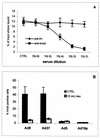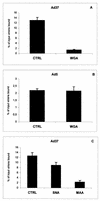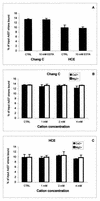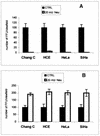Adenovirus type 37 uses sialic acid as a cellular receptor on Chang C cells
- PMID: 12163603
- PMCID: PMC136979
- DOI: 10.1128/jvi.76.17.8834-8841.2002
Adenovirus type 37 uses sialic acid as a cellular receptor on Chang C cells
Abstract
Epidemic keratoconjunctivitis (EKC) is a severe eye infection caused mainly by adenovirus type 8 (Ad8), Ad19, and Ad37. We have shown that the EKC-causing adenoviruses use sialic acid as a cellular receptor on A549 cells instead of the coxsackie-adenovirus receptor, which is used by most adenoviruses. Recently, Wu et al. (Virology 279:78-89, 2001) proposed that Ad37 uses a 50-kDa protein as a receptor on Chang C conjunctival cells and that this interaction is independent of sialic acid. According to the American Type Culture Collection, this cell line carries HeLa cell markers and should be considered to be a genital cell line. This prompted us to investigate the function of sialic acid as a cellular receptor for Ad37 in Chang C cells. In this study, we demonstrate that enzymatic removal or lectin-mediated blocking of cell surface sialic acid inhibits the binding of Ad37 virions to Chang C cells, as does soluble, virion-interacting sialic acid-containing substances. The binding was Ca2+ or Mg2+ ion independent and mediated by the knob domain of the trimeric viral fiber polypeptide. Moreover, Ad37 virions infected Chang C cells and two other genital cell lines (HeLa and SiHa) as well as a corneal cell line in a strictly sialic acid-dependent manner. From these results, we conclude that Ad37 uses sialic acid as a major receptor in cell lines derived from both genital and corneal tissues.
Figures







Similar articles
-
A 50-kDa membrane protein mediates sialic acid-independent binding and infection of conjunctival cells by adenovirus type 37.Virology. 2001 Jan 5;279(1):78-89. doi: 10.1006/viro.2000.0703. Virology. 2001. PMID: 11145891
-
Adenovirus type 37 binds to cell surface sialic acid through a charge-dependent interaction.Virology. 2002 Oct 10;302(1):33-43. doi: 10.1006/viro.2002.1503. Virology. 2002. PMID: 12429514
-
Crystal structure of species D adenovirus fiber knobs and their sialic acid binding sites.J Virol. 2004 Jul;78(14):7727-36. doi: 10.1128/JVI.78.14.7727-7736.2004. J Virol. 2004. PMID: 15220447 Free PMC article.
-
Adenovirus interaction with its cellular receptor CAR.Curr Top Microbiol Immunol. 2003;272:331-64. doi: 10.1007/978-3-662-05597-7_11. Curr Top Microbiol Immunol. 2003. PMID: 12747555 Review.
-
Tropism and transduction of oncolytic adenovirus 5 vectors in cancer therapy: Focus on fiber chimerism and mosaicism, hexon and pIX.Virus Res. 2018 Sep 15;257:40-51. doi: 10.1016/j.virusres.2018.08.012. Epub 2018 Aug 17. Virus Res. 2018. PMID: 30125593 Review.
Cited by
-
Sialic acid on herpes simplex virus type 1 envelope glycoproteins is required for efficient infection of cells.J Virol. 2007 Apr;81(8):3731-9. doi: 10.1128/JVI.02250-06. Epub 2007 Jan 17. J Virol. 2007. PMID: 17229687 Free PMC article.
-
Virus recognition of glycan receptors.Curr Opin Virol. 2019 Feb;34:117-129. doi: 10.1016/j.coviro.2019.01.004. Epub 2019 Mar 5. Curr Opin Virol. 2019. PMID: 30849709 Free PMC article. Review.
-
Homotrimeric, beta-stranded viral adhesins and tail proteins.J Bacteriol. 2003 Jul;185(14):4022-30. doi: 10.1128/JB.185.14.4022-4030.2003. J Bacteriol. 2003. PMID: 12837775 Free PMC article. Review. No abstract available.
-
Extended receptor repertoire of an adenovirus associated with human obesity.PLoS Pathog. 2025 Jan 30;21(1):e1012892. doi: 10.1371/journal.ppat.1012892. eCollection 2025 Jan. PLoS Pathog. 2025. PMID: 39883726 Free PMC article.
-
Coagulation factor binding orientation and dimerization may influence infectivity of adenovirus-coagulation factor complexes.J Virol. 2013 Sep;87(17):9610-9. doi: 10.1128/JVI.01070-13. Epub 2013 Jun 26. J Virol. 2013. PMID: 23804638 Free PMC article.
References
-
- Adrian, T., G. Wadell, J. C. Hierholzer, and R. Wigand. 1986. DNA restriction analysis of adenovirus prototypes 1 to 41. Arch. Virol. 91:277-290. - PubMed
-
- Araki-Sasaki, K., K. Y. Ohasi, T. Sasabe, K. Hayashi, H. Watanabe, Y. Tano, and H. Handa. 1995. An SV-40-immortalized human corneal epithelial cell line and its characterization. Investig. Ophthalmol. 36:614-621. - PubMed
-
- Arcasoy, S. M., J. Latoche, M. Gondor, S. C. Watkins, R. A. Henderson, R. Hughey, O. J. Finn, and J. M. Pilewski. 1997. MUC1 and other sialoglycoconjugates inhibit adenovirus-mediated gene transfer to epithelial cells. Am. J. Respir. Cell Mol. Biol. 17:422-435. - PubMed
Publication types
MeSH terms
Substances
LinkOut - more resources
Full Text Sources
Other Literature Sources
Miscellaneous

